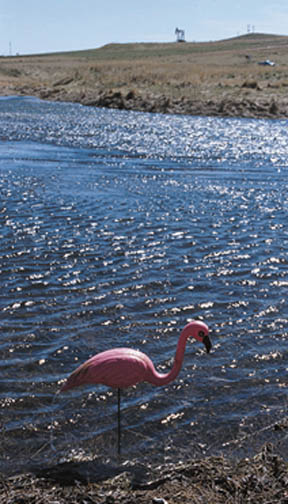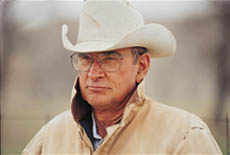|
|
|
| Subscriptions click here for 20% off! | E-Mail: info@rangemagazine.com |
|
|
||||||||||||||
 |
WATERWORLD Thanks to the coal bed methane gas
|
|||||||||||||
| Earl Boardman isn’t one to go looking for trouble; indeed, he much
prefers open spaces and the serenity of mother nature to the aggravations
of city life. But after two water wells that service the Wyomingite’s
7,000-acre cattle ranch suddenly went dry, Boardman blew a fuse.
The culprit? A methane gas drilling crew poking holes in a hillside
just beyond his property line. Alerted that Earl had gone looking for his shotgun, Johnson County Sheriff Larry Kirkpatrick stepped in to negotiate a truce. A meeting was set up, and Bill Strickler, president of Michiwest Energy Inc. of Mount Pleasant, Mich., flew out to consult with the aggrieved rancher. Michiwest offered to drill Boardman two new water wells, free of charge. They even tossed in two submersible pumps, plus free electricity for three years. “They’re honest old boys,” Boardman concedes. “They said, ‘We’re pretty sure we dried ’em up, and it proves that we’re doing what we want to do–sucking down that water in the aquifer, and methane gas is comin’ up. Since we broke it, we’re gonna try to fix it.’ And they did.” End of story? Not according to Boardman, who worries that the rapidly expanding coal bed methane gas boom could wreak environmental havoc in northeastern Wyoming. What will become of the aquifer should an additional 15,000 holes be punched into it? And what about all the water that comes up with the gas? Where will it go and what effect will it have on the land? |
||||||||||||||
| Water is the major by-product of the extraction process. A single methane bore can discharge 18 to 20 gallons per minute. And strange as it may seem, dozens of plastic pink flamingoes are appearing in “new” waters across Wyoming. |
||||||||||||||
| WILL A RIVER RUN THROUGH IT? Tom and Helen Jones, who are Boardman’s nearest neighbors, are also worried. Since 1944 the Jones family has grazed cattle in the Powder River Basin, during which time they’ve survived numerous droughts and witnessed at least 15 floods. Tom remembers one time following a three-inch cloudburst when Dead Horse Creek was running eight feet deep. He and his father had to swim their horses across the muddy torrent to get home, dodging snags and ducking debris as they went. If methane drilling continues unchecked, such adventures could become routine. “See, we live right on the mouth of Dead Horse,” says Jones, “and all the cumulative water above us will be coming here. It would be a flood every day. If they turn it loose like the drillers in the methane company want to, why, the creek will be running 12 feet deep.” Besides the inconvenience of being cut off from the highway and the danger of being drowned, Jones is concerned what effect so much water will have on his pastureland. “The creek bed is not designed for water the year round,” he explains. “When there’s water on it all the time, it gets real boggy. And muddy. And all the bottom land, hay meadows and stuff, will be under water.” |
||||||||||||||
 |
||||||||||||||
| Earl Boardman worries that the coal bed methane gas boom could wreak environmental havoc in northeastern Wyoming. |
||||||||||||||
|
That’s precisely what happened to rancher Ken Claybaugh’s hay
fields, which lie along nearby Wild Horse Creek and downstream
from as many as 45 coal bed methane wells operated by Houston-based
CMS Oil and Gas. After Claybaugh complained, the Wyoming Oil and
Gas Conservation Commission ordered the wells shut down–until
such time as the environmental consequences of pouring one and
a half million gallons of water onto the ground per day can be
determined.
|
||||||||||||||
|
To Subscribe: Please click here for subscription or call 1-800-RANGE-4-U for a special web price Copyright © 1998-2005 RANGE magazine last page update: 04.03.05 |
||||||||||||||
